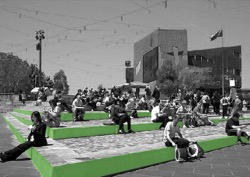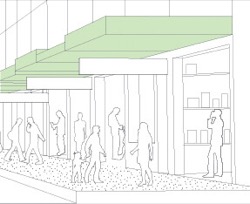On this page:
About street spaces and plazas
Street spaces are that part of the street used for social purposes, such as a widened footpath or a pedestrian-only mall.
Plazas range from a building forecourt to a large city square. A plaza is often bordered by buildings or streets.
Most street spaces and plazas are paved, and can include trees and other planting, but they are distinguished from parks. The spaces may have vehicles running adjacent to the pedestrian zone, be a shared zone, or may be free of vehicles.Some street spaces operate for specific periods of the day or week to accommodate different use patterns.
While street spaces are generally publicly owned and managed, plazas may be publicly or privately owned but still open to the public at all hours.
Why is it important?
Streets are the predominant and most frequently used public spaces in any city. Street spaces and plazas link with the movement network, allowing people to use them as through routes as well as places to linger and socialise.
They usually have places for people to sit, eat their lunch, find some sun or shade, get out of the cold wind or rain, chat with friends or watch their children play. They also provide opportunities for people to observe the world around them.
3.2.1: ensure attractive and functional street spaces and plazas
- Locate a street space or plaza where pedestrian volumes will be high.
Tip: high pedestrian numbers help the street space or plaza to feel safe and attractive.
- Allow sufficient space in the street space or plaza to accommodate activities and seating, in addition to the space for pedestrian through-paths.

Tip: beware of making the street space or plaza too big. A bit of crowding at busy times is acceptable but an empty space may discourage people.
3.2.2: ensure convenient and safe access to and through plazas
- Arrange through-paths across a plaza on the same level as the surrounding pedestrian network.
Tip: level changes, steps and obstructions reduce accessibility and hinder way finding, discouraging pedestrians from entering a plaza.
3.2.3: establish and support activity around the edges of street spaces and plazas
A street space or plaza performs well when bordered by pedestrian priority streets and buildings with a high level of activity that open on to the space.
- Provide an active front to buildings on at least one side of the street space or plaza.
Tip: buildings with uses that engage with the street, such as cafes, provide opportunities for interaction with and use of the street space.
- Where possible integrate shelters and awnings with the facades of buildings that are facing street spaces and plazas.

Tip: integrating shelters by attaching them onto the building wall allows the street spaces to remain uncluttered. The Building Code of Australia sets out design standards for building projections beyond the street alignment. Refer to 5.1 Buildings in activity centres and 6 Objects in the public realm. - Enable adjacent businesses to use the street space for café furniture and to display merchandise.
Tip: commercial use of a street space may require local standards to be set to ensure obstacle free paths and safe pedestrian movement.
- Provide a transition zone between traffic lanes and a street space or plaza.
Tip: a transition zone may be landscaped verge or row of on–street car parking.
Page last updated: 28/10/25